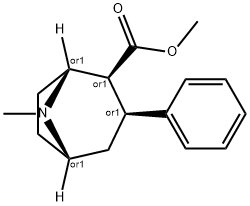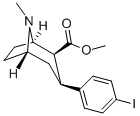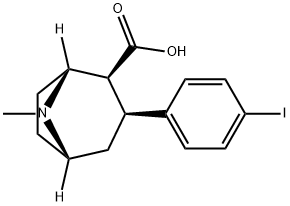8-AZABICYCLO[3.2.1]OCTANE-2-CARBOXYLIC ACID, 8-(3-FLUOROPROPYL)-3-(4-IODOPHENYL)-, METHYL ESTER (1R,2S,3S,5S)-
- CAS NO.:155798-07-5
- Empirical Formula: C18H23FINO2
- Molecular Weight: 431.283
- MDL number: MFCD08061453
- SAFETY DATA SHEET (SDS)
- Update Date: 2022-12-21 16:56:50
![8-AZABICYCLO[3.2.1]OCTANE-2-CARBOXYLIC ACID, 8-(3-FLUOROPROPYL)-3-(4-IODOPHENYL)-, METHYL ESTER (1R,2S,3S,5S)- Structural](https://img.chemicalbook.in/CAS/GIF/155798-07-5.gif)
What is 8-AZABICYCLO[3.2.1]OCTANE-2-CARBOXYLIC ACID, 8-(3-FLUOROPROPYL)-3-(4-IODOPHENYL)-, METHYL ESTER (1R,2S,3S,5S)-?
Absorption
Absorption is 100% because administered I.V.
Description
loflupane was launched as a new imaging agent for investigation of the dopaminergic neurons and the early diagnosis of Parkinson’s disease and related syndromes. This (123I) iodine-labeled agent was developed for imaging with single-photon emission computed tomography (SPECT); it binds to dopamine transporters on cerebral neurons, enabling the detection of an eventual loss of functional neurons, particularly in the striatal region. The use in clinical routine of SPECT technique with this new agent generates reliable and reproducible results in healthy control subjects as well as in patients with Parkinson’s disease. So, it displays a quantification of striatal dopaminergic function and can help in the identification of the parkinsonian syndromes and their differentiation from syndromes due to other diseases. The major metabolic reactions in healthy humans are hydrolysis of the ester bond to the free acid and N-dealkylation to the 123-I labeled noranalog.
Originator
Research Biochemicals Int (UK)
Indications
Ioflupane I-123 is a SPECT (single photon emission computerized tomography) agent used to distinguish between Parkinson’s syndrome tremors and essential tremor.
Background
Ioflupane (I-123) is a radiopharmaceutical used to image dopamine neurons and diagnose Parkinsonian syndromes.
Definition
ChEBI: An azabicycloalkane that is ecgonine methyl ester in which the N-methyl group is replaced by 3-fluoropropyl and the 3beta-hydroxy group is replaced by 4-(123I)iodophenyl. Used for the imaging of dopa ine transporters in the brain of adult patients with potential Parkinsonian Syndromes.
brand name
DatSCAN
Pharmacokinetics
iodine-123 labeled ioflupanebinds selectively to striatal presynaptic dopamine neurons by binding reversibly to presynaptic dopamine transporters.
Metabolism
Not Available
Properties of 8-AZABICYCLO[3.2.1]OCTANE-2-CARBOXYLIC ACID, 8-(3-FLUOROPROPYL)-3-(4-IODOPHENYL)-, METHYL ESTER (1R,2S,3S,5S)-
| Melting point: | 82-83° |
| alpha | D24 -12.8° |
Safety information for 8-AZABICYCLO[3.2.1]OCTANE-2-CARBOXYLIC ACID, 8-(3-FLUOROPROPYL)-3-(4-IODOPHENYL)-, METHYL ESTER (1R,2S,3S,5S)-
Computed Descriptors for 8-AZABICYCLO[3.2.1]OCTANE-2-CARBOXYLIC ACID, 8-(3-FLUOROPROPYL)-3-(4-IODOPHENYL)-, METHYL ESTER (1R,2S,3S,5S)-
New Products
4,4-Difluoropiperidine hydrochloride tert-butyl 9-methoxy-3-azaspiro[5.5]undecane-3-carboxylate Indole Methyl Resin N-Isopropylurea N,N-Dicyclohexylcarbodiimide(DCC) MELDRUMS ACID 5-METHYLISOXAZOLE-4-CARBOXYLIC ACID Magnessium Bis glycinate Zinc ascorbate 1-bromo-2-butyne 2-acetamidophenol 9(10H)-anthracenone Erythrosin B, 4-Piperidinopiperidine 2-((4-morpholinophenylamino) (methylthio) methylene) malononitrile 2,4-dihydroxybenzaldehyde 3-(4-morpholinophenylamino)-5-amino-1H-pyrazole-4-carbonitrile Methyl 2-methylquinoline-6-carboxylate 2,6-dichloro-4-nitropyridine 4-Bromo-2-chlorobenzonitrile 2-(benzylamino)acetic acid hydrochloride 4-(tert-Butoxycarbonylamino)but- 2-ynoic acid 3,4-dihydro-2H-benzo[b][1,4]dioxepine 1-Phenyl-1-cycloprppanecarboxylicacidRelated products of tetrahydrofuran

![8-AZABICYCLO[3.2.1]OCTANE-2-CARBOXYLIC ACID, 8-(3-FLUOROPROPYL)-3-(4-IODOPHENYL)-, METHYL ESTER (1R,2S,3S,5S)-](https://img.chemicalbook.in/CAS/GIF/155797-99-2.gif)



![8-AZABICYCLO[3.2.1]OCTANE-2-CARBOXYLIC ACID, 8-(3-FLUOROPROPYL)-3-(4-IODOPHENYL)-, METHYL ESTER (1R,2S,3S,5S)-](https://img.chemicalbook.in/CAS/GIF/155798-07-5.gif)
You may like
-
 3-(4-amino-1-oxoisoindolin-2-yl)-1-methylpiperidine-2,6-dione 98%View Details
3-(4-amino-1-oxoisoindolin-2-yl)-1-methylpiperidine-2,6-dione 98%View Details -
 1-methylindoline-2,3-dione 98%View Details
1-methylindoline-2,3-dione 98%View Details
2058-74-4 -
 614-19-7 98%View Details
614-19-7 98%View Details
614-19-7 -
 3112-85-4 Methyl phenyl sulfone 98%View Details
3112-85-4 Methyl phenyl sulfone 98%View Details
3112-85-4 -
 20677-73-0 (2,2-diethoxyethyl)methylamine 98%View Details
20677-73-0 (2,2-diethoxyethyl)methylamine 98%View Details
20677-73-0 -
 3-(4-(hydroxyamino)-1-oxoisoindolin-2-yl)piperidine-2,6-dione 98%View Details
3-(4-(hydroxyamino)-1-oxoisoindolin-2-yl)piperidine-2,6-dione 98%View Details -
 57381-49-4 2-bromo-4-chlorobenzonitrile 98%View Details
57381-49-4 2-bromo-4-chlorobenzonitrile 98%View Details
57381-49-4 -
 4,6-dichloropyrimidine-5-carbaldehyde 98%View Details
4,6-dichloropyrimidine-5-carbaldehyde 98%View Details
5305-40-8
